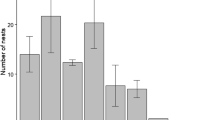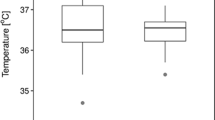Abstract
The Chinese Penduline Tit (Remiz consobrinus) is a small passerine that breeds in Northeast Asia. Despite its common appearance and its high encounter rate, the breeding biology of this species has remained largely unknown. In this paper, we describe for the first time the breeding biology and parental care system of the Chinese Penduline Tit in the coastal area of Northeast China. As a migratory species of birds, it arrives at the Liaohe Delta in late April, the males establish territories in early May, and breeding pairs build their nests from May to July. Most nest building occurs from mid-May to early June. The females produce small white eggs (egg mass, 1.0 ± 0.1 g) and a clutch size of 6.8 ± 0.6 eggs. The parental care system is complicated in Chinese Penduline Tits: uniparental care is dominant (80%) in this population, with a majority (71%) of female-only care and 9% male care for all brooding nests, together with 4% biparental care and 16% biparental desertion. Chicks hatch after 13.9 ± 1.0 days of incubation and fledge after 22.1 ± 1.0 days. The hatching success and nestling survival are 86.7 and 80.6%, respectively. Furthermore, breeding failure is 23.4%, which is commonly caused by predation and nests blown away by strong winds. Compared to other species of the Remiz genus, the Chinese Penduline Tit shows much similarity to the Eurasian Penduline Tit (Remiz pendulinus) but large differences compared to the White-crowned Penduline Tit (Remiz coronatus) with respect to breeding habitat, breeding density, nest site selection and parental care system. Moreover, the good nest attributes, relatively high nestling survival and low risk of nest failure may contribute to the prevalence of the uniparental care system in this Chinese Penduline Tit population.
Zusammenfassung
Brutbiologie und Brutpflegestrategie der wenig erforschten Chinabeutelmeise (Remiz consobrinus) Die Chinabeutelmeise (Remiz consobrinus) ist eine kleine Singvogelart, die in Nordostasien brütet. Trotz ihres häufigen Auftretens und einer hohen Beobachtungsrate ist die Brutbiologie dieser Art noch immer weitgehend unbekannt. In diesem Artikel liefern wir die erste Beschreibung der Brutbiologie und des Brutpflegesystems der Chinabeutelmeise in der Küstenregion Nordostchinas. Als Zugvogelart erreicht sie das Liao He-Delta Ende April, die Männchen gründen Anfang Mai ihre Reviere und die Brutpaare bauen von Mai bis Juli ihre Nester. Ein Großteil des Nestbaus findet von Mitte Mai bis Anfang Juni statt. Die Weibchen legen kleine weiße Eier (Eimasse: 1,0 ± 0,1 g); die Gelegegröße beträgt 6,8 ± 0,6 Eier. Das Brutpflegesystem der Chinabeutelmeisen ist kompliziert: In dieser Population überwog die Fürsorge durch ein Elternteil (80 %), wobei sich in der Mehrzahl (71 %) nur das Weibchen und in 9 % nur das Männchen um alle Brutnester kümmerte; in 4 % der Fälle waren es beide Elternteile und 16 % der Nester wurden von beiden Elternteilen verlassen. Die Küken schlüpften nach einer Bebrütungsdauer von 13,9 ± 1,0 Tagen und waren nach 22,1 ± 1,0 Tagen flügge. Weiterhin lag die Brutausfallrate bei 23,4 %; die Ursachen waren gewöhnlich Prädation und ein Fortwehen der Nester durch starken Wind. Im Vergleich mit anderen Arten der Gattung Remiz zeigt die Chinabeutelmeise bezüglich Bruthabitat, Brutdichte, Nistplatzwahl und Brutpflegesystem eine große Ähnlichkeit mit der eurasischen Beutelmeise (Remiz pendulinus), unterscheidet sich aber stark von der Kronenbeutelmeise (Remiz coronatus). Darüber hinaus könnten die guten Nesteigenschaften, die relativ hohe Überlebensrate der Nestlinge sowie das geringe Nestausfallrisiko zur Prävalenz der Brutpflege durch ein Elternteil in dieser Population der Chinabeutelmeise beitragen.





Similar content being viewed by others
References
Adamou AE, Tabib R, Kouidri M, Ouakid ML, Glądalski M, Bańbura A, Bańbura J (2017) Inter-annual variationin clutch size and laying date of Rufous Bush Chats Cercotrichas galactotes inhabiting an Algerian oasis. J Arid Environ 141:40–44
Aparicio JM (1994) The seasonal decline in clutch size: an experiment with supplementary food in the kestrel, Falco tinnunculus. Oikos 71(3):451–458
Ball AD, Van Dijk RE, Lloyd P, Pogány Á, Dawson DA, Dorus S, Bowie RCK, Burke T, Székely T (2017) Levels of extra-pair paternity are associated with parental care in penduline tits (Remizidae). Ibis 159:449–455
Beissinger SR, Snyder NFR (1987) Mate desertion in the Snail Kite. Anim Behav 35:477–487
Bergstrom PW (1988) Breeding biology of Wilson’s Plovers. Wilson Bull 100(1):25–35
Béziers P, Roulin A (2016) Double brooding and offspring desertion in the Barn Owl Tyto alba. J Avian Biol 47:235–244
Bleeker M, Kingma SA, Szentirmai I, Székely T, Komdeur J (2005) Body condition and clutch desertion in penduline tit Remiz pendulinus. Behaviour 142:1465–1478
Bot S, Van Dijk RE (2009) Black-headed Penduline Tits Remiz macronyx in Kazakhstan. Sandgrouse 31:171–176
Bot S, Brinkhuizen D, Pogány Á, Székely T, Van Dijk R (2011) Penduline tits in Eurasia: distribution, identification and systematics. Dutch Bird 33:177–187
Cockburn A (2006) Prevalence of different modes of parental care in birds. Proc R Soc B Biol Sci 273:1375–1383
Dubois F, Cézilly F (2002) Breeding success and mate retention in birds: a meta-analysis. Behav Ecol Sociobiol 52:357–364
Fontaine JJ, Martin TE (2006) Parent birds assess nest predation risk and adjust their reproductive strategies. Ecol Lett 9:428–434
Franz D (1991) Paarungssystem und Fortpflanzungsstrategie der Beutelmeise (Remiz pendulinus). J Ornithol 132:241–266
Gil-Delgado JA, Marco E, Paredes M, Vives-Ferrabduz C (2005) Seasonal clutch size variation of multi-brooded bird species: comparisons between breeding season and latitudes. Ibis 147:206–212
Gluschenko YN, Burkovskiy OA, Tiunov IM (2014) The history of the settling of the Chinese Penduline Tit Remiz consobrinus (Remizidae, Passeriformes, Aves) in the Primorsky Krai Territory. Achiev Life Sci 8:133–136
Houston AI, Székely T, McNamara JM (2005) Conflict between parents over care. Trends Ecol Evol 20:33–38
Kingma SA, Szentirmai I, Székely T, Bókony V, Bleeker M, Liker A, Komdeur J (2008) Sexual selection and the function of a melanin-based plumage ornament in polygamous penduline tits Remiz pendulinus. Behav Ecol Sociobiol 62:1277–1288
Lack D (1968) Bird migration and natural selection. Oikos 19(1):1–9
Li D, Ruan Y, Wang Y, Chang AK, Wan D, Zhang Z (2016) Egg-spot matching in Common Cuckoo parasitism of the Oriental Reed Warbler: effects of host nest availability and egg rejection. Avian Res 7(1):21
Lu X, Yu T, Liang W, Yang C (2010) Comparative breeding ecology of two White-bellied Redstart populations at different altitudes. J Field Ornithol 81(2):167–175
Ludvig E, Vanicsek L, Torok J, Csorgo T (1995) Seasonal variation of clutch size in the European Blackbird Turdus merula: a new ultimate explanation. J Anim Ecol 64:85–94
Martin T (1995) Avian life history evolution in relation to nest sites, nest predation, and food. Ecol Monogr 65(1):101–127
Matysioková B, Remeš V (2013) Faithful females receive more help: the extent of male parental care during incubation in relation to extra-pair paternity in songbirds. J Evol Biol 26:155–162
Mei Y, Ma M, Hu B, Dusan B, Szekely T (2009) Nests and nest-site selection of White-crowned Penduline Tit (Remiz coronatus) in the Northern Xinjiang. Zool Res 30:565–570
Mészáros AL, Kajdocsi S, Szentirmai I, Komdeur J, Székely T (2006) Breeding site fidelity in penduline tit Remiz pendulinus in Southern Hungary European. J Wildl Res 52:39–42
Nice MM (1957) Nesting success in altricial birds. Auk 74:305–321
Parker G (1979) Sexual selection and reproductive competition in insects. In: Blum MS, Blum NA (eds) Sexual selection and sexual conflict. Academic Press, New York, pp 123–166
Persson O, Öhrström P (1989) A new avian mating system: ambisexual polygamy in the penduline tit Remiz pendulinus. Ornis Scand 20:105–111
Pilastro A, Biddau L, Marin G, Mingozzi T (2001) Female brood desertion increases with number of available mates in the Rock Sparrow. J Avian Biol 32:68–72
Pogány Á, Szentirmai I, Komdeur J, Székely T (2008) Sexual conflict and consistency of offspring desertion in Eurasian Penduline Tit Remiz pendulinus. BMC Evol Biol 8:242
Pogány Á, Van Dijk R, Horváth P, Székely T (2012) Parental behavior and reproductive output in male-only cared and female-only cared clutches in the Eurasian Penduline Tit (Remiz pendulinus). Auk 129:773–781
Queller DC (1997) Why do females care more than males? Proc R Soc B Biol Sci 264:1555–1557
Schleicher B, Valera F, Hoi H (1993) The conflict between nest guarding and mate guarding in penduline tits (Remiz pendulinus). Ethology 95:157–165
Székely T, Cuthill IC, Kis J (1999) Brood desertion in Kentish Plover sex differences in remating opportunities. Behav Ecol 10:185–190
Szentirmai I, Komdeur J, Székely T (2005a) What makes a nest-building male successful? Male behavior and female care in penduline tits. Behav Ecol 16:994–1000
Szentirmai I, Szekely T, Liker A (2005b) The influence of nest size on heat loss of penduline tit eggs. Acta Zool Acad Sci Hung 51:59–66
Szentirmai I, Székely T, Komdeur J (2007) Sexual conflict over care: antagonistic effects of clutch desertion on reproductive success of male and female penduline tits. J Evol Biol 20:1739–1744
Tong JC, Zhou WW, Yang XM, Jiang ML (1985) Studies on the breeding ecology of the penduline tit. Acta Zool Sin 31(2):154–161
Van Dijk RE, Szentirmai I, Székely T (2007) Practical field guide for investigating breeding ecology of penduline tits Remiz pendulinus. Version 1.2. Univ. of Bath. http://www.bath.ac.uk/bio-sci/biodiversitylab/pdfs/PT_%20Field%20Guide_21_22.pdf. Accessed 16 July 2008
Van Dijk RE, Pilon AE, Szentirmai I, Székely T, Komdeur J (2008) The influence of habitat structure on sexual conflict over care in Penduline Tits Remiz pendulinus Woodpecker. Ardea 96:3–11
Van Dijk RE, Brinkhuizen D, Székely T, Komdeur J (2010a) Parental care strategies in Eurasian Penduline Tit are not related to breeding densities and mating opportunities. Behaviour 147:1551–1565
Van Dijk RE, Pogány Á, Komdeur J, Lloyd P, Székely T (2010b) Sexual conflict predicts morphology and behavior in two species of penduline tits. BMC Evol Biol 10:107
Van Dijk RE, Székely T, Komdeur J, Pogány Á, Fawcett TW, Weissing FJ (2012) Individual variation and the resolution of conflict over parental care in penduline tits. Proc R Soc B Biol Sci 279(1735):1927–1936
Willson MF (1966) Breeding ecology of the yellow-headed blackbird. Ecol Monogr 36:51–77
Wolda H (1978) Seasonal fluctuations in rainfall, food and abundance of tropical insects. J Anim Ecol 47:369–381
Acknowledgements
We appreciate the assistance of the Liaohe Delta National Nature Reserve for allowing us to conduct the fieldwork. We sincerely thank Boshi Liang, Zhen Wang, Shaoping Zhang, Zhuoxue Chen and all the volunteers for their assistance in the fieldwork. We thank Jan Komdeur and Charlotte Deerenberg for helpful comments on the previous version of this manuscript. We also thank Sjouke Kingma and an anonymous reviewer for providing very useful comments. Thanks to Dr Yu Liu, Dr De Chen and Dr Pinjia Que for providing detailed suggestions on manuscript writing. This study was financially supported by the National Natural Science Foundation of China (nos. 31572288 to Z. Z., 31301888 and 31672316 to D. L.) and the General Scientific Research Project of the Education Department of Liaoning Province (L2015196 to D. L.). All the fieldwork and monitoring complied with the current laws of China.
Author information
Authors and Affiliations
Corresponding author
Additional information
Communicated by F. Bairlein.
Rights and permissions
About this article
Cite this article
Zheng, J., Li, D. & Zhang, Z. Breeding biology and parental care strategy of the little-known Chinese Penduline Tit (Remiz consobrinus). J Ornithol 159, 657–666 (2018). https://doi.org/10.1007/s10336-018-1553-0
Received:
Revised:
Accepted:
Published:
Issue Date:
DOI: https://doi.org/10.1007/s10336-018-1553-0




